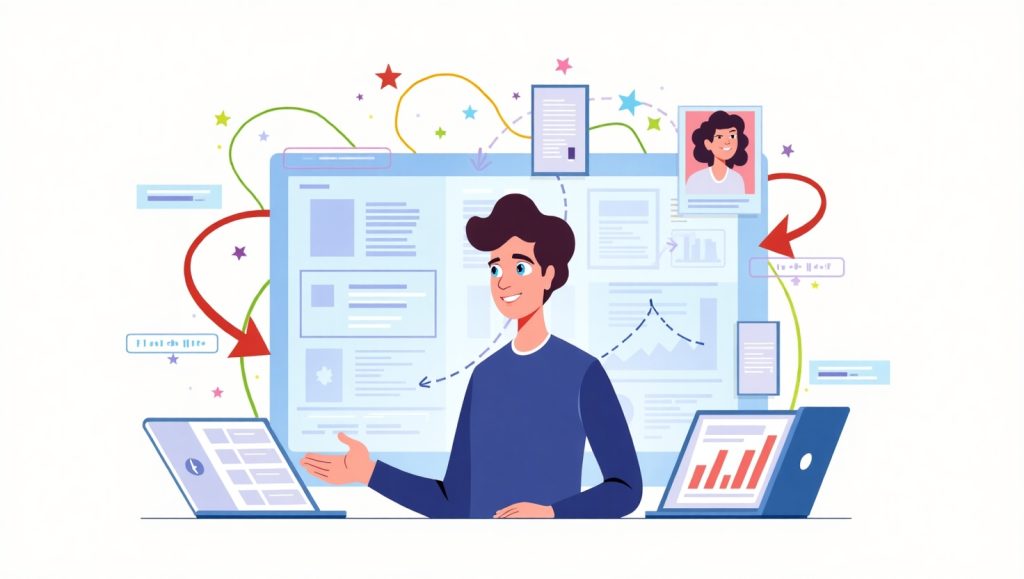
When going through the thoughtful process of designing a digital product, you’ll encounter many key concepts and principles, with one of the most significant but sometimes underappreciated being affordance. It’s that little indicator or hint that identifies what users can do with an object, such as a button that looks click-able, or a slider that has arrows with both ends suggesting you can drag it. Affordances inform users on how they can navigate your interface and perform an action without being told explicitly. This is why understanding and applying affordances can relay helpful information to users that can positively transform their entire user experience (UX) on your website or app.
By understanding and implementing affordances, designers can curb confusion, reduce errors, and create smoother user flows. For novice users or seasoned users, affordances help to create their expectations of what actions they can undertake and can make the interaction feel intuitive and natural. In this article, we will be talking about what affordances are, when they are significant in UX, how to include them in your designs, and how they relate to overall design and usability of a website.
What Are Affordances in UX Design?
The Basics of Affordance
Affordance, in design, refers to the perceived and actual properties of an object that dictate how it can be used. The term was introduced by psychologist James J. Gibson and was later adapted by Don Norman in design. For example, a door handle affords pulling, while a flat panel affords pushing.
For user experience design, an affordance indicates to the user how to engage with an interface element. A raised button affords a click, a slider affords a drag, and underlined text affords a hyperlink. These visual properties contribute to familiarity and friction.
Why Affordances Make or Break UX
If your application or website does not articulate how it works, users may feel confused (and confused users leave). Affordance is important because it is intuitive. Good design will not explain everything, it will behave through visual and interactive clue.
Users should not have to think about how to use your product. They should just know how that product works, and that’s the affordance. A product that utilizes affordance and does so well will ultimately feel more intuitive, and that plays a significant role in user satisfaction.
Types of Affordances You Should Know
Explicit vs. Implicit Affordances
There are different types of affordances designers work with:
- Explicit Affordances are obvious. A button labeled “Submit” that’s raised and looks clickable is a perfect example.
- Implicit Affordances rely on learned behaviors. For instance, users know from experience that underlined blue text is usually a link.
By combining both, designers cater to a wider range of users—those who are new and those who are experienced.
False and Hidden Affordances
Sometimes affordances go wrong:
- False Affordances are misleading cues. A word might be underlined but isn’t clickable.
- Hidden Affordances are interactive elements without clear cues. Users can’t tell they can interact unless they experiment.
Both of these can cause confusion. That’s why clear, consistent design patterns—such as those discussed in articles about how important are design patterns in web development —are essential in UX.
Why Affordances Improve User Satisfaction

Enhancing Clarity and Confidence
Affordances can help make user’s interactions flow smoothly, because when a user knows what to do at a glance, they feel confidence building their trust in your product, and decreasing the need for help or onboarding materials.
Now think of your favorite mobile app. Similar to how your favorite app feels a breeze to use because it affords action through visuals, their placement and behavior. And that ease of use comes from effective design affordances.
Reducing Cognitive Load
Users tend to process visual information faster than they do textual or written instructions. So if an interface has visual clarity about what’s interactive, not too much reasoning has to happen to perform a specific task, lessening cognitive load (one of the core principles in UX). When cognitive load is lowered, users are able to more easily complete a task and return to the task in the future.
Good affordances turn guesswork into intuitive action. They are especially important for interfaces based on speed and precision like e-commerce checkout, navigation systems, etc.
How to Design Strong Affordances in Your Interfaces
Visual Cues: Shape, Color, and Feedback
Designers use visual elements to signal affordance. A button might stand out through color, shadow, or placement. A hover effect can reinforce that something is clickable. Micro-interactions, such as a slight movement when clicked, give users feedback that reinforces correct usage.
Consistency is key. If every button on your site looks and behaves the same, users will pick up on the pattern and know what to do—even if they’re visiting for the first time.
Text Labels and Icons
Words matter. Pairing visual cues with clear labels makes affordances stronger. An icon alone might be confusing, but adding a word underneath—like “Share” or “Save”—makes it obvious. This is particularly useful in global products where users may not speak the same language fluently.
Common Mistakes Designers Make with Affordances
Overdesigning or Underdesigning Elements
Some designers will aim for excessive minimalism to the point of removing important clues that a user may need in order to navigate resources. In the opposite direction, other designers overdesign interfaces, creating cluttered resources where all elements seem to compete for attention.
Finding the right balance ultimately satisfies sufficient cues, without overwhelming the user. To create an effective button, a button should look like a button without using three shadows and making it pulse!
Affordances describe the visual aspects of design, but they also describe universal usability. Many users use screen reading technology, keyboard navigation, or change colour contrast. If your affordances are not usable, you will be excluding part of your audience.
Affordances and Conversion Rates
Guiding Users to Action
Powerful affordances bring users in the direction of desired actions — signing up, checking out, clicking a call to action. The clearer the path, the higher those interactions result in conversions. This is noteworthy as we adopt higher conversion web design strategies that optimize each interaction point for clarity and momentum.
Your CTA should look like a button, visually pop, and change on hover and click. This provides users confidence that they are headed in the right direction.
Minimizing Drop-Offs
A typical cause of collar drop-offs due to hesitation. If users are unsure of what they should do next, they’ll drop off. Affordances interrupt that hesitation by making it feel obvious to the user what to do. Every subsequent second that is saved from the user second-guessing impacts is increasing the chances they will stay and complete an action.
This is one of the simplest ways to reduce the bounce rates and improve retention rates; simply checking to see that they see and understand what comes next.
Conclusion
Affordances aren’t sexy or sophisticated – they’re simple. But they’re unbelievably powerful. Affordances are the guiding force behind your product, allowing users to walk through your product without having to read anything. Focusing on affordances when designing your product leads to experiences that are easy to interpret, build on easy and thorough to uncover, and ultimately fulfilling.
Excellent UX design doesn’t shout at users – it offers insightful cues. It communicates everything without overburdening. Whether it’s a startup MVP or a complex SaaS platform, understanding affordances allows you to create interfaces that users will trust and think they’re fun to use.
Affordances are a valuable component to your UX toolbox. Just like usability testing, responsive design, and accessibility, affordances should be heavily anchored in your toolkit. The more robustly your product works, the better your chances are at retaining users, and that’s the ultimate objective of user-centered design.